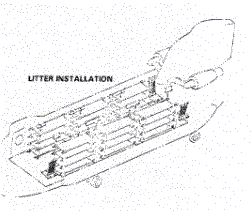 The CH-47 Chinook Helicopter has a capacity of
24 litter patients, or 31 ambulatory patients, or a combination of litter
and ambulatory patients. The CH-47 Chinook Helicopter has a capacity of
24 litter patients, or 31 ambulatory patients, or a combination of litter
and ambulatory patients.
Because of its' large size and rotor blade diameters, it is most suited
to larger landing zones. It should not be brought into an LZ smaller than
40 meters in diameter.
 The web seats for ambulatory patients are located along the periphery
of the cabin. When configured for litter patients, some or all of the
seats can be replaced with poles and straps for banks of litters, 4 high.
The various mixed configurations are listed here: The web seats for ambulatory patients are located along the periphery
of the cabin. When configured for litter patients, some or all of the
seats can be replaced with poles and straps for banks of litters, 4 high.
The various mixed configurations are listed here:
|
Litter and Ambulatory Configurations of the
CH-47 |
| Ambulatory |
Litter |
| 31 |
0 |
| 25 |
4 |
| 19 |
8 |
| 16 |
12 |
| 10 |
16 |
| 4 |
20 |
| 1 |
24 |
Litter patients requiring in-flight medical care should be positioned
so they can receive this care.
Litter patients are loaded through the lowered rear door and ramp.
Litter racks are loaded from top to bottom and from the front of the
helicopter to the back. If a mixture of litter and ambulatory patients are
loaded, the litter patients should be loaded toward the rear of the
helicopter, and ambulatory patients toward the front.
 If circumstances do not allow for configuring the CH-46 Chinook for
litter patients, the web seats can fold up against the wall (with straps)
and litters can be placed on the floor of the helicopter. In this
improvised situation, do the best you can to secure the litters to the
floor, to avoid movement during maneuvering or in the event of turbulence. If circumstances do not allow for configuring the CH-46 Chinook for
litter patients, the web seats can fold up against the wall (with straps)
and litters can be placed on the floor of the helicopter. In this
improvised situation, do the best you can to secure the litters to the
floor, to avoid movement during maneuvering or in the event of turbulence.
Unless a medical team has been dispatched to accompany the CH-46
Chinook, there will be no medical attendants and no medical supplies
aboard, other than the first aid kits for the aircrewmembers.
Approved for public release; Distribution is unlimited.
The listing of any non-Federal product in this CD is not an
endorsement of the product itself, but simply an acknowledgement of the source.
Operational Medicine 2001
Health Care in Military Settings
Bureau of Medicine and Surgery
Department of the Navy
2300 E Street NW
Washington, D.C
20372-5300 |
Operational Medicine
Health Care in Military Settings
CAPT Michael John Hughey, MC, USNR
NAVMED P-5139
January 1, 2001 |
United States Special Operations Command
7701 Tampa Point Blvd.
MacDill AFB, Florida
33621-5323 |
This web version is provided by
The Brookside Associates Medical Education Division.
It contains original contents from the official US Navy NAVMED P-5139, but has
been reformatted for web access and includes advertising and links that were not
present in the original version. This web version has not been approved by the
Department of the Navy or the Department of Defense. The presence of any
advertising on these pages does not constitute an endorsement of that product or
service by either the US Department of Defense or the Brookside Associates. The
Brookside Associates is a private organization, not affiliated with the United
States Department of Defense.
Contact Us · · Other Brookside
Products
|
 The CH-47 Chinook Helicopter has a capacity of
24 litter patients, or 31 ambulatory patients, or a combination of litter
and ambulatory patients.
The CH-47 Chinook Helicopter has a capacity of
24 litter patients, or 31 ambulatory patients, or a combination of litter
and ambulatory patients.
 The web seats for ambulatory patients are located along the periphery
of the cabin. When configured for litter patients, some or all of the
seats can be replaced with poles and straps for banks of litters, 4 high.
The various mixed configurations are listed here:
The web seats for ambulatory patients are located along the periphery
of the cabin. When configured for litter patients, some or all of the
seats can be replaced with poles and straps for banks of litters, 4 high.
The various mixed configurations are listed here: